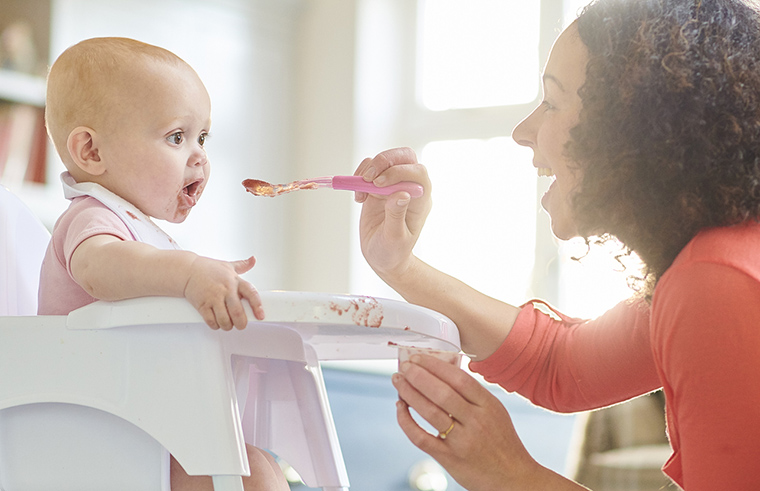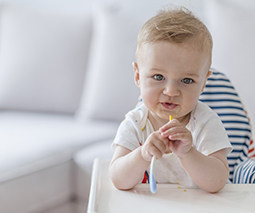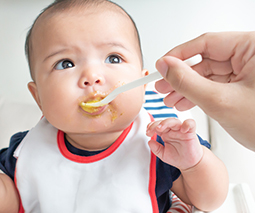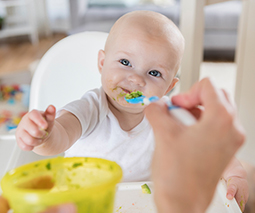Paediatric nutritionist, Mandy Sacher answers your top 5 first foods questions

It can be confusing to know when and how to introduce your baby to solid food. Paediatric nutritionist, Mandy Sacher, agrees that the transition from exclusively breastfeeding or bottle feeding your baby to introducing solids can be a tricky time to navigate. Fortunately, Mandy has some helpful tips to make the journey from breastfeeding to first foods smooth sailing.
Question 1: How do I encourage my baby to eat lumpy foods?
Lola asks: “My nine-month-old simply hates any lumpy food. He enjoys his purees and will happily gum a hard teething rusk to a sodden mess. He only has two teeth so far, but the slightest lump in his pureed food and he gags and spits it right out. Same goes when I’ve tried to give him steamed carrot sticks, sweet potato and broccoli as finger foods. No matter how soft I make them, he only makes one attempt and if he realises it’s broken off in his mouth, he gags, spits and refuses to touch it again. Is there anything I can do to encourage him onto something other than purees?”
Mandy says: I really advocate that when we start solids, we should offer a blended version, so not just finger foods and not just purees. From six months, we should try to offer babies purees alongside finger foods because the longer we delay certain textures, the more fussy babies will become.
If a nine-month-old baby is rejecting lumpy foods, we need to start doing a little bit of work. There are a couple of strategies to try. First of all, outside of eating times, we can offer baby something called ‘hard munchables’ – this would be something like a hard carrot, or a hard zucchini just to play with outside of feeding times so they start to get used to different textures. But when you offer these, you have to really watch your baby. Babies can’t be left unattended with food.
With mealtimes, offer your nine-month-old purees alongside the steamed carrot and steamed broccoli, and show him how he could use that as a dipper, or even offer some sourdough toast and spread the puree onto the toast. So we’re starting to mix wet textures with more dry textures.
The golden rule when these kind of issues arise is repetition and perseverance. So going forward, at every meal I would recommend having both a puree and a finger food, then role-modelling how to eat it by dipping and putting it in your own mouth, and encouraging your baby to do the same. But don’t give up, and keep going.
Question 2: My seven-month-old baby prefers solids to breastfeeds. What should I do?
Catarina asks: “I waited until six months to start introducing solid food to my baby because that was what was recommended by my baby health nurse. Since then, my baby only wants to eat solid food. She has lost all interest in breastfeeding, which I know should still be giving her most of her nutrients. My baby just loves to eat from a spoon and cries and fusses if I offer her the breast first. Should I stop offering solid food entirely to get her back on the breast properly? Or just give up and offer solid food first? I’m worried that she is weaning herself now and she’s still only seven months old. I’m really confused about what I should be doing. Help!”
Mandy says: If a baby’s being introduced to solid food before the age of six months, we always offer breast first. So if we’re introducing lunch or a midday meal to a four or five-month-old, we would first give them their mid-morning or lunch feed of breastmilk or formula, and then half an hour later we would offer the solid food. But from six months, there’s absolutely no problem offering a baby their solid meal first and then, depending on your baby’s sleep and eating cycles, waiting 30 to 40 minutes to offer breastmilk or formula.
Refusing milk could just be a little stage, and you might have to rejig your schedule and timing. We cannot give up on milk and formula before the age of one, so keep persevering.
And remember that from six months onwards, there’s no harm in offering solids first, so if your baby really wants a solid meal, offer the solid meal first and then half an hour later try to offer the milk feed.
Question 3: I’m anxious my baby will choke. What are the safest first foods?
Meg asks: “My bub is eight months old and loves her pureed foods. She’s sitting well in the highchair and starting to grab the spoon and suck on it during feeds, so I feel it’s time to move on to some soft finger foods for her. But I’m so afraid of my baby choking that I’ve held off on giving her anything but puree so far. The anxiety is real. I even had my hubby give her the first puree feed at six-and-a-half months because I was so nervous that I hovered over him with my phone in hand ready to dial triple zero if she choked. I’m crazy, I know. I’d love to know what foods are the safest to start with, and also which foods are choking risks. My anxiety is through the roof about this, but I know we have to start somewhere.”
Mandy says: You are not crazy! This is a very common anxiety. And this is the number one reason why finger foods are delayed. But remember that from six months, our babies can start on finger food. If you are scared and anxious about starting finger food, I would really recommend getting your husband, a friend, or another family member to be there by your side.
It takes a community to bring up children and with something difficult that you’ve got anxiety about, instead of giving yourself a hard time, get all the support and resources you need.
You asked, ‘what is safe food?’. If food is prepared correctly, things like avocado, papaya, mango, broccoli, steamed broccoli, steamed cauliflower, baked sweet potato wedges, lamb cutlet, grilled strips of chicken and fish, are all excellent first finger foods.
Things that we would avoid are things like cherry tomatoes and grapes. If you have been told by your paediatrician or GP that you need to start introducing peanuts, we would never offer a whole nut to a baby, we would always do it in the form of smooth peanut butter. And to begin with, definitely avoid things like popcorn, small peas and blueberries.
I hope that’s helped a little bit. And one last tip: if you’re still feeling really anxious and nervous, you can get little mesh feeders – they’re available in most pharmacies and Big W. They’ve got a little net you can put the food in, so there’s absolutely no way your baby can choke. For a lot of mums that I’ve seen or spoken to in workshops, they would use the mesh feeder for one to two weeks until they start to feel more comfortable with finger foods.
Question 4: Should I be topping up my baby’s breastfeeds with formula or solids?
Alexandra asks: “My GP recommended starting solids at four months to keep my baby full after breastfeeds. Would you recommend this? At the moment I’m topping up breastfeeds with formula.”
Mandy says: Any age between four to six months is appropriate, however what I’m giving is general advice. I would say to all the mums, if you’re working with a GP or paediatrician, always take their advice. For example, you may have a baby that has a casein allergy, which means that they’re allergic to the milk protein; for these babies, starting at four months might be necessary.
Every baby shows ready cues at different times; things like being able to sit upright when they’re supported, their tongue thrust reflex starting to disappear, and showing an interest in food. This could happen at four months, five months, or six months. There are pros and cons of offering food at four months as opposed to six months. New research has shown that if we introduce solids at around four months, that has an impact on the reduction of allergies. And also, this gives you time to let your baby explore without the pressure, because by six months, things like iron are no longer met solely through breastmilk or formula. So that’s why introducing solids by six months is so important.
But if you do introduce earlier, at four months, you can start to expose your baby to a whole variety of veggies, and some fruit, before they get to those more complex foods.
For other mothers, it doesn’t feel right to introduce solids to their baby before six months. So in my Starting Solids course, for example, I’ve got meal plans that show you how to introduce solids at four months, five months and six months. Because there are small differences in terms of how quickly you go, and the types of foods you start to introduce at these different ages. But just to emphasise – any time between four to six months is appropriate. Never before four months, and we definitely don’t advocate after six months for introducing solids.
There’s so much conflicting information. I always love to provide guidelines and give all the facts, but every family is unique and different. What works for one family may not work for another, but when you have those guidelines, you can make the best choice for your baby and for you.
Question 5: When can I add flavour to my baby’s food?
Amy asks: “When can I start to flavour my baby’s food with herbs and other gentle spices?”
Mandy says: If you’re a foodie and you like to eat out, then bringing your baby up on bland food is probably not going to be the best thing, especially if you’ve got hopes of taking them out for Thai, Indian and Italian. So once your baby’s been introduced to single flavours and started things like pumpkin, sweet potato, and you start to offer combination foods like lamb with pumpkin and sweet potato, you can start to use safe spices and herbs.
Things like cinnamon, turmeric, vanilla, coriander, cumin – these can all be introduced from six months onwards.
Watch Mandy Sacher answer your questions about first foods:
Head over to the Facebook event page for details on all the sessions in our second Q&A series for parents! Get your questions ready for our team of Bub and Me experts to answer live.
The Babyology Masterclass series is sponsored by BIG W, where you can find everything you need for pregnancy, baby and beyond.





